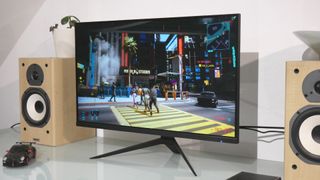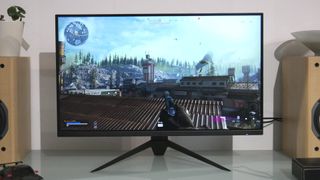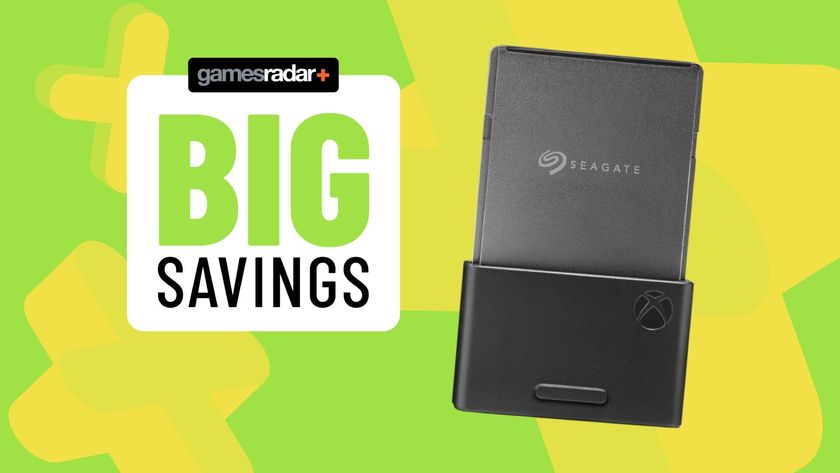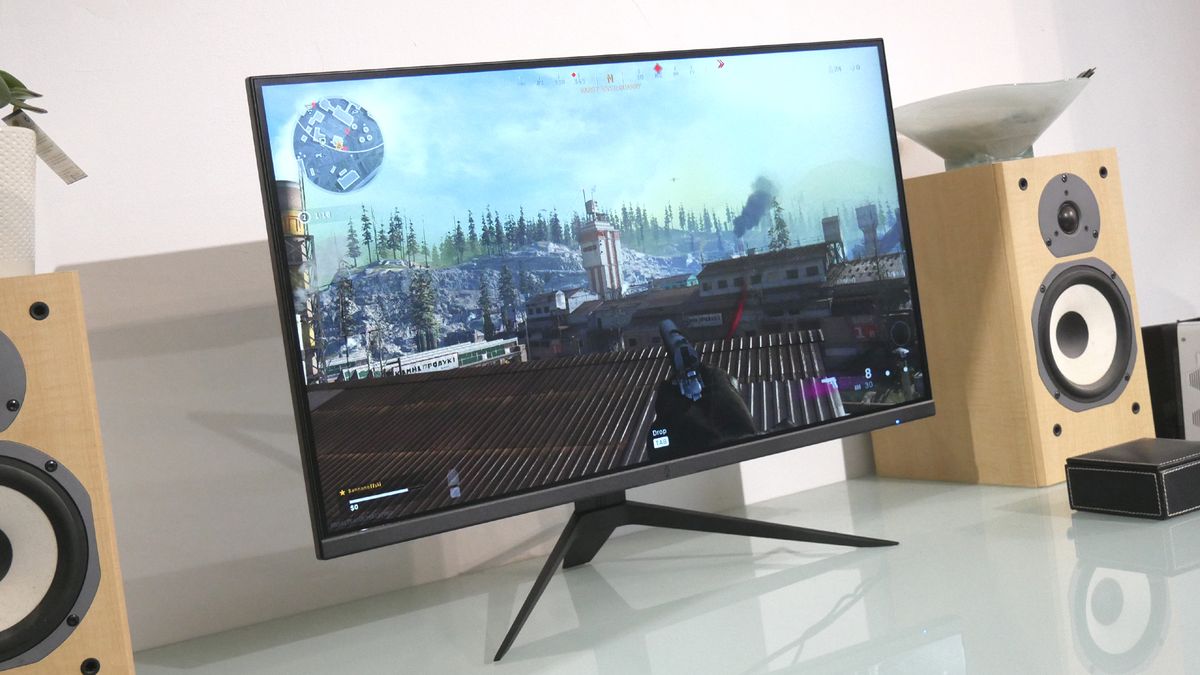12DOVE Verdict
Seriously quick, plenty of punch, but short on pixels
Pros
- +
Speedy 240Hz panel
- +
Surprisingly good HDR implementation
- +
Slick, sharp design
Cons
- -
1080p resolution lacks detail
- -
1440p a better compromise for most gamers
Why you can trust 12DOVE
Fewer pixels makes for faster frame rates. That’s the basic premise behind a 1080p gaming panel like the new Monoprice Dark Matter 27-inch Gaming monitor. This is the latest 240Hz model with a super fast 1ms IPS-type panel and DisplayHDR 400 certification.
The idea is to combine that 240Hz and 1ms pace with decent colour accuracy and a little HDR sizzle. The snag? 27 inches is a big panel over which to stretch that modest 1080p pixel grid. A super sharp, high-DPI experience this most certainly will not be. Of course, pretty much any, including the best gaming monitors, are a trade-off, a compromise between competing priorities. So, how well does this one work?

Design & Features
Out of the box, this new Monoprice Dark Matter 27-inch Gaming Monitor model impresses with a slick, minimalist design. The metal base of the stand in particular is really sharp and makes for a techy, precision vibe. The slim bezels help with that, too. We like.
At its core, this monitor is based on a 27-inch 1,920 by 1,080 pixel panel from AU Optronics. It’s an IPS-type panel (strictly speaking it’s an AHVA panel which is AU’s take on LG’s IPS tech) with true 8-bit color and VESA DisplayHDR 400 certification.
The latter is entry-level HDR stuff, but does at least mean you can display an HDR signal accurately. Just be aware you don’t get local dimming, so this monitor is not capable of true HDR rendering.
The panel’s contrast rating of 1,000 to one is likewise standard for this class of display, while inputs are covered off by one DisplayPort 1.2 socket, one HDMI 2.0 port, and an HDMI 1.4 connector. Whether you’re planning on using this panel with a PC or console, or maybe both, then, you’re well catered for.
The real fun starts with that 240Hz refresh. Monoprice also rates the pixel response at a speedy 1ms, though it’s not clear if that’s via the GTG or MPRT metric, the latter typically being a less demanding measure of pixel performance. No matter, it’s the subjective performance that counts, which we’ll come to momentarily.
Adaptive refresh is covered by AMD FreeSync Premium, brightness is an impressive 500 nits and Monoprice says it’s good for 99 percent coverage of the sRGB gamut. That’s not actually all that impressive - sRGB is not a demanding color space and any really color-accurate display will well exceed 100 percent coverage. But this is a gaming panel, not a pro content creation display. So, that’s OK.

Performance
Initial impressions in default SDR mode are of a decent but not hugely punchy panel. However, switch over to HDR mode (on a PC that requires enabling HDR both in Windows and in the Dark Matter’s OSD menu) and this thing really wakes up. It’s so much brighter and more vibrant and suddenly feels good for that 500 nit rating.
It’s worth noting that improvement applies to SDR content, too. The Dark Matter handles SDR content in HDR mode particularly well, so it’s entirely practical to run this monitor in HDR mode all the time. As for HDR content, that looks good, too, though the difference compared to SDR content isn’t hugely dramatic. A good example is Cyberpunk 2077. Running in HDR it looks that little bit snazzier and more vibrant. But it’s not a huge upgrade.
Anywho, another strong point is pixel response. Monoprice includes user-configurable overdrive for pepping up pixel performance. The two fastest settings suffer from a touch of overshoot. But it’s not too noticeable in-game. Instead, it’s more obvious when scrolling text in a web browser or similar. In any case, if overshoot and inverse ghosting do niggle, you can ramp the overdrive down a notch and - poof - it’s gone.
Either way, this is a very fast and responsive panel. Running at 240Hz in PC shooters like Apex Legends and Fortnite is frankly electrifying. You’d have to be an awfully, awfully serious esports player to feel the need for anything faster.
Of course, for console gaming the 240Hz refresh is overkill. Even the PS5 and Xbox Series X top out at 120Hz. So for pure console gaming, Monoprice will do you a cheaper 165Hz model that’s good enough as a PS5 monitor or Xbox Series X monitor. As for color accuracy, the factory calibration is actually quite good, with little to no visible compression, banding, or other image flaws.
If all that sounds great, what’s the catch? Ultimately, there’s no avoiding the fact this is a fairly low resolution monitor. Games that major on sheer graphical eye candy, like the aforementioned Cyberpunk or a cutting edge driving game like Forza Horizon 4 look awfully soft and lacking in detail compared to even a 1440p monitor of the same size, let alone anything you'd find vying for a spot on our best 4K monitor for gaming guide.

Overall - should you buy it?
Speed or visual detail. What is your preference? The Monoprice Dark Matter 27-inch Gaming Monitor has the former in spades. But with a 1080p pixel grid spread over a 27-inch LCD panel, it’s a little lacking in the latter. It really is a speedy IPS gaming panel, but you'll have to ask yourself whether 1080p is enough.
You can, of course, achieve both in a single monitor. But that will cost you in terms of not only the cost of the screen itself but also the PC hardware you’ll need to drive it - check out our best gaming PC or best gaming laptop guides for a good start on decent hardware. So, if you’re all about online shooters and you can’t stretch to a 1440p monitor and the graphics hardware required to achieve really high frame rates at that resolution, this makes for a welcome alternative. It’s seriously quick, has plenty of visual punch, and looks satisfyingly slick.
Note: The Monoprice Dark Matter 27 240Hz is rarely available outside of the USA. We've also spotted some Dark Matter 27 models with a lower Hz rating, so make sure you're getting the correct model when buying.
A serious dissertation on the finer points of input lag and overshoot followed by a forensic examination of AI-accelerated temporal upscaling. Such is a routine day in the working life of long-time tech wordsmith, Jeremy Laird. Along with GamesRadar, Jeremy’s 15-year back catalogue includes a host of tech and gaming outlets, including TechRadar and PC Gamer, not to mention contributions to mainstream media from the Independent to the Evening Standard. Complimenting Jeremy’s debilitating addiction to all kinds of digital hardware, he is also afflicted by an obsession with and a significant occupational sideline in cars and automotive technology.

The 2TB Seagate Expansion Card has returned to a price I haven't seen since last year's Black Friday

Sneaky restock notes suggest Pokemon Prismatic Evolutions is likely to return to stores in May

The Witcher 4 has "a huge team" focused on the believability of the RPG's world, because even things like trees and foliage always need to belong












